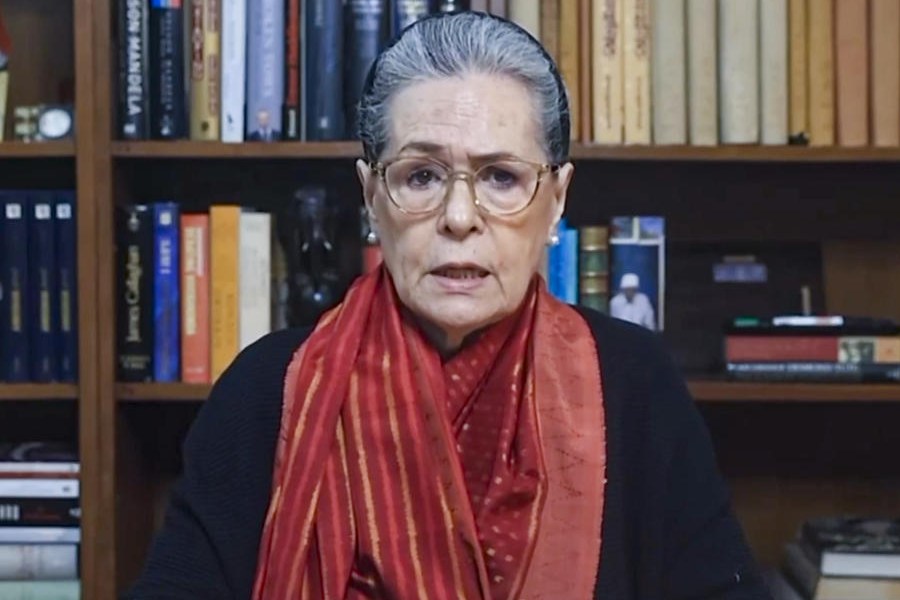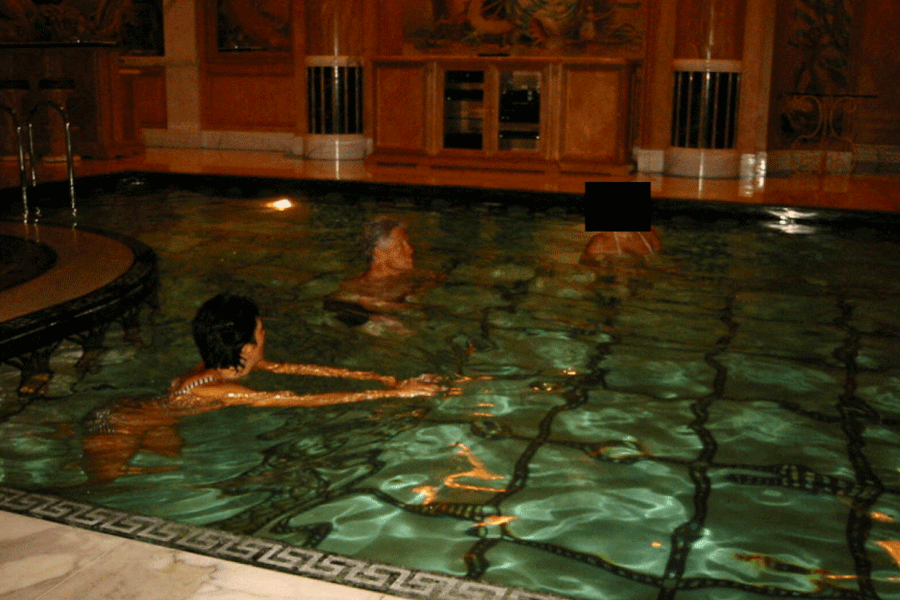|
|
“There is no happiness in the Mahabharata.” Ganesh Pyne’s comment on the text that looms like a dark shadow over his artistic imagination bleakly distils its power to disturb. Our history — itihasa — so given to us by tradition, is one of unhappiness. To say this is more than to assert the inevitability of death, just as Yudhisthira’s refusal of cruelty (anrsamsya) is not a refusal of violence (ahimsa). For death and violence are not in our power, as the Bhagavadgita shows, but suffering and cruelty are. The Mahabharata, an intensely human work, is preoccupied above all with human wrongdoing and human suffering. The visitor to Ganesh Pyne: His Mahabharata (until January 8, 2011) at the CIMA gallery in Calcutta is witness to a modernist master’s profound and uniquely moving engagement with this history of pain.
At the core of the exhibition are eight major tempera canvases featuring moments and characters whose importance is both acknowledged and disacknowledged by the epic, from the game of dice to the hunter Ekalavya. These are surrounded by other, often equally powerful, depictions in crayon, charcoal or mixed media, and jottings from the artist’s notebook interspersing preliminary sketches with a welter of written observations, quotations, crossings-out and doodles. This generic range is familiar to viewers of Pyne’s work, who may think of his small, closely filled pages of jottings and sketches as private ancillaries to the major canvases. That impression of an intimate history of the artwork is misleading, as Pyne himself acknowledges. The jottings are as carefully structured and placed as the paintings themselves. If anything, they reinforce the enigmatic quality of the final work, rather than explain it. But in their relating of line drawing and text, they look back equally to Pyne’s beginnings as an animation artist and to a lifetime’s readings and reflections, as in his comment on the bird-catcher Ekalavya, who should have been Arjuna’s mighty opposite on the battlefield, but was excluded from it, his thumb sacrificed to its politics of race and inheritance.
The tensions established between different forms of representation call attention to the mystery of representation itself, the fear, emptiness and stillness that inhabit Pyne’s major canvases as properties of the act of visualization. In his prefatory comments on this series, he speaks of a sense of helplessness at the problem of transferring the dynamism of a story, “unfolding in perpetual motion”, to a succession of still images. As we pass from picture to picture in the exhibition, ourselves living beings in motion, consumed by time, traversing space, yet directed not by linear logic but by visual desire, we are recurrently conscious of this phenomenological paradox. G.E. Lessing, contrasting the consecutive order of the verbal text with the spatial contiguities of the visual image, the “continuous action” of Homer’s Iliad to the “arrested action” of the marble Laocoön, commented on the artist’s need to seize the “pregnant moment”, the nodal image from which all action, all reflection, all retrospection, flow.
Pyne’s work is a succession of such pregnant moments, moments filled with history, with memory, with pain. Distinctively, however, they do not — even in the large mixed-media sketch of the war itself — attempt to emulate or reproduce the dynamism of narrated action. There is, by contrast, a pure modernist emphasis upon the nature itself of still media, an absorption in the introspective, reflective property of the moment of viewing, a property transferred to the figures themselves, each caught up in a private act of meditation.
In consequence, the present opus, on which Pyne has been occupied for the past two years, is not a set of illustrations to the oral or written text, or to myths and legends deeply lodged in childhood and adult memory. Pyne has earlier worked as an illustrator, and a number of Mahabharata drawings produced between 1967 and 1987 were displayed at the National Gallery of Modern Art in Mumbai in 2000. But his new Mahabharata is a rare solo exhibition of work created to be viewed together, though there can be no guarantee, given market pressures, that it can be kept together in future. It is for this reason that this exhibition is possibly a unique occasion. In its perfection, its matching of artistic purpose to receptive occasion, it calls attention to the dispersal that marks the public space of art, as in the modern museum that houses disparate work produced at different times. Pyne himself, a notoriously reclusive genius in his early years, has been reluctant to commit himself to solo exhibitions, preferring to allow individual canvases to create their own space of viewing, islands of attention and concentration within the flux of crowds at a gallery. This mode of presentation is present here too, but the viewer experiences, unusually, the imaginative solace of an occasion where the artist speaks exclusively, at length, and by design, to her. This situatedness, this aura that Walter Benjamin feared that the modern artwork had lost, is paradoxically preserved only as a trace through mechanical reproduction, in the exhibition catalogue that survives after the collection has been broken up.
It is possible to view the paintings, crayons and sketches in a roughly narrative series at the CIMA gallery, but there is no necessity to do so. Moreover, Pyne notes that there are episodes he has omitted, such as the Pandavas’ period of disguise; events he has invented, such as the dead Ghatotkacha in his father Bhima’s lap; and iconography for which he has taken recourse to latter-day folk devotion, such as Lord Jagannatha’s image at Draupadi’s disrobing, or the figure of Kali on the field of death. His gaze is focused on figures at the margins of heroic history, those whom epics mention but neglect (kavye upekshita, Rabindranath called them): women such as Amba, Saubali, Duhsala, Chitrangada, Gandhari, and Draupadi, the abjected Ekalavya, the lonely survivor Yuyutsu, the self-exiled advisor Vidura.
Over his epic vision brood the three dark presences who inhabit the core of the Mahabharata narrative but are removed from it by politics, gender and history: Krishna, the dark god, patron of the Pandavas, Arjuna’s charioteer; Draupadi, also called Krishnaa, intent on a revenge she cannot carry out herself; and the epic narrator himself, Krishnadvaipayana Vyasa, both outside the tale and inside it, advising Yudhisthira, son of Dharma.
How is darkness to be made visible? Pyne comments on the difficulty of grasping the elusive essence of Krishna, in himself a figure for the darkness — in every sense — of the epic as a whole. In one great canvas, he is shown as a black standing silhouette on Arjuna’s chariot, mysterious but purposeful, holding the reins with his left hand, his right resting on Arjuna’s shoulder. By contrast, the hero is sunk in a state of abstraction, his eyes closed, waiting to be instructed. Eyes, closed and open, are perhaps what move us most directly in Pyne’s canvases. Deliberately created as relatively flat surfaces, eschewing realist illusionism for a simultaneously modern and traditional language of distortion and elongation, they return the viewer’s gaze with a more direct, more powerful looking-out. This gaze is sometimes concentrated in the open eyes of the represented figure, as in the terrible grief of Bhima holding his son’s head on his lap, the agony of Karna attempting to lift the wheel, the helplessness of Asvatthama, the bright sidelong glance of death-dealing Kali, the staring eyes of Jagannatha. At other times, the picture looks at us with eyes wide shut, as in the lidded ‘gaze’ of Ekalavya, of Yudhisthira dreaming of a mound of skulls on the battlefield, of Bhishma on his deathbed, or even of the blindfolded Gandhari.
But this gaze of the artwork, a gaze that unsettles and haunts us, is achieved only through a complex minimalism of means. Pyne’s palette has only the colours of night, blood and earth — black, red and brown — combined with the spectral paleness of deceit, as in Sakuni’s white hands, and the ash of Vidura’s ascetic hunger. The figures are clad in simple vestments for which Pyne refers to Uday Shankar’s operatic choices of mythological costume. Above all, the composition of scenes — such as the game of dice, or of the disrobing of Draupadi — speak of profound attention to the spatial order of the canvas, filled and dominated by the represented figures, yet asking us to reflect upon the event, something that is beyond representation. The final impression, in so crowded an epic, is of profound, unearthly solitude. For this viewer at least, that solitude belongs to the hero Yudhisthira, true reporter of mortality to the Yaksha beside the poisoned lake. That scene, central to Buddhadeva Bose’s classic work on the Mahabharata, cannot be shown. It is behind the hooded eyes of the dreaming hero.












